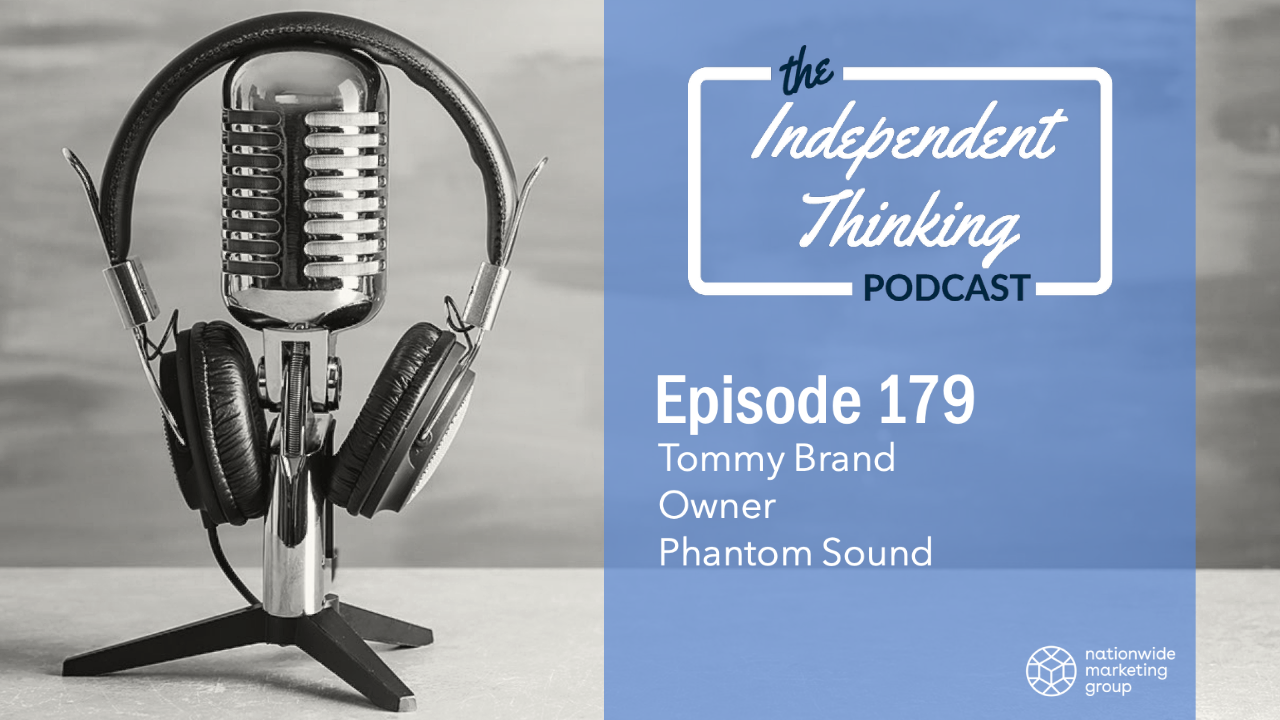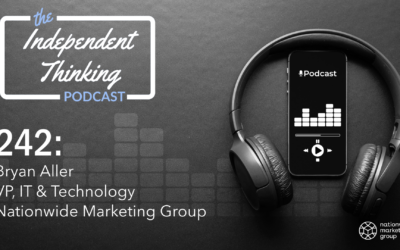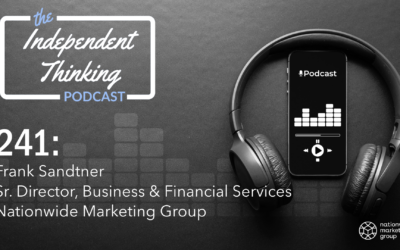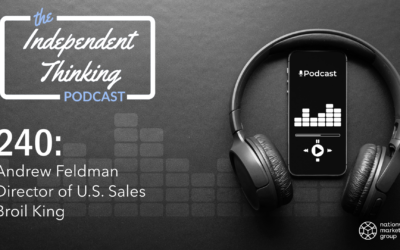Phantom Sound, a custom integration firm based out of Mason, Ohio — a suburb of Cincinnati — has a steep 35-year history that includes thousands of completed projects and four held design patents. The company’s owner, Tommy Brand, acquired the firm in 2022 and is, for all intents and purposes, a rookie in the CI space. Brand shares his story, what attracted him to Phantom Sound, and his plan to help the company continue to grow.
Rob Stott: All right, we are back on the Independent Thinking Podcast and sitting down right now with Tommy Brand, owner of Phantom Sound. Now, Cincinnati, Ohio, but you’re kind of in between Cincy and Dayton, is that right? Officially?
Tommy Brand: Yeah. We’re in a suburb of Cincy called Mason, Ohio. It’s probably equidistant from Dayton to Cincinnati, but they consider themselves a Cincinnati suburb.
Rob Stott: Gotcha. Okay. Well, I mean I’ve got familiarity with Dayton. I went to school, I don’t know if you know Duquesne in Pittsburgh, but-
Tommy Brand: I’m familiar with it a little bit.
Rob Stott: Well, the A-10 background, Duquesne was an A-10 basketball school, so we always got to go to Dayton. A school that people probably know it for hosting the First Four, right?
Tommy Brand: The First Four, right.
Rob Stott: They also made it, the one year, to the First Four. Talk about an unfair advantage, getting a First Four game in your home arena.
Tommy Brand: Yeah, the Flyers are historically a pretty decent team every year.
Rob Stott: They are. We always had a tough time playing them as the Dukes. But neat little connection there.
Tommy Brand: Cool.
Rob Stott: Well, first of all, thank you for taking the time and sitting down with us and doing a podcast.
Tommy Brand: Sure. Yeah, my pleasure. This is cool.
Rob Stott: For those that don’t know, give a little background on yourself, your path through the industry and what led you to Phantom Sound.
Tommy Brand: Sure. First and most importantly, I guess, I’m a husband and a father. Geez, I’m over 50 now. That’s a long time. I’ve got four girls that are all out of college, just barely, and trying to get them off the payroll. My lovely wife, Laura, we’ve been married now for over 13 years, so going strong there.
Career-wise, I have an accounting and finance degree and worked in corporate for the first 20 years of my career. Did CFO and controller work, and then decided I didn’t want to work for anyone anymore, so I kind of jumped off of that eight or nine years ago and started doing some business development for a company I was a partner in.
That’s how I came across Phantom Sound at the time. Phantom’s been around since 1988, and I didn’t know about them until probably four or five years ago. I started doing some business development in the Home Builders Association of Greater Cincinnati and networking, and got to know the previous owner of Phantom, and over a of couple years had beers and talk and chat, and he was trying to retire and get to Florida. And so, one thing led to another, and ended up buying Phantom last March. March of ’22.
Rob Stott: Wow.
Tommy Brand: I’m new to the industry, I’m new to Phantom Sound, and new to Oasys. Just new all around, I guess. So what do I know about? I don’t know all that much, maybe.
Rob Stott: It’s unique. That’s a cool kind of origin story in the space. What made you gravitate towards the company or in this industry?
Tommy Brand: Again, I didn’t have any experience in the industry, but I got to know the old owner. Good guy. We kind of hit it off a little bit and were friendly. Trusted him, had a good business model, had a good business, was profitable, making money, and a little more than your average CI, I think, as far as the intellectual property goes.
We have our own line of speakers. They’re architecturally hidden speakers. Inside. We’ve got a couple products for outside, as well. I was intrigued by that. We had four patents in the company. They were really design patents on the whole-house sound. I thought that was a pretty unique niche to have. And so all of that combined, it was a good business opportunity.
Rob Stott: That’s awesome. You mentioned those patents. That’s something we’ll dive into in a little bit. It’s kind of unique. Now I want to dig into, you’re kind of coming to this industry. Obviously, you’re learning a lot, right? Drinking from a fire hose, learning about custom integration. Anything kind of surprise you about this space as you’re getting your hands dirty?
Tommy Brand: It’s pretty broad. There’s a lot of different areas, a lot of different disciplines in this. Over the last 18 months, I’ve tried to dive into the business and learn a lot about the sales and sales process, and a lot about how we schedule, how we purchase, and all the different facets. Even going out on the job site and doing some work with our techs and with our team, trying to earn their trust and learn how everything works. I feel like I’m a little behind. Coming into the company, we didn’t have a lot of process documented.
Rob Stott: Sure.
Tommy Brand: We’re a small company, six and a half people, and we just kind of ran on Excel, Post-it Notes, pads of paper, and stuff like that. We quoted out of Portal, and we do use QuickBooks on the back end, but in between there was really nothing. So just kind of diving in head first, trying to help the team, and build a good process-oriented business so we can grow and help everyone move up and grow their personal repertoire of skills, I guess.
Rob Stott: You sound like a perfect candidate. A few episodes back we had Jason Sayen. You talk about process-
Tommy Brand: Oh, yeah.
Rob Stott: That’s exactly what we talked about on the podcast. I don’t know if you’ve connected with him yet, but he’s a process ninja.
Tommy Brand: Yeah, I heard him down in Nashville. We’re nowhere close to where we need to be, but I can aspire.
Rob Stott: We all can. I don’t think we all wear colored karate belts of levels of process like he does.
Tommy Brand: No.
Rob Stott: But good dude to certainly connect with. But, it’s a unique sort of story. Everyone’s is different and that’s what I love about covering, you talk about 5,000 retailers that are part of Nationwide, but I mean even just the CI space and learning how for some it’s as simple as they tinkered with a toy when they were young, and that’s what got them into it.
Tommy Brand: Got stuck in their head, yeah.
Rob Stott: So, unique to hear that.
Tommy Brand: Another interesting fact before we go off of that is our founder, he’s a guy by the name of Howard McGurty, and he’s 80 now, and he still comes in part-time, two days a week. He does some R&D for us, and he also helps assemble speakers.
Rob Stott: Wow.
Tommy Brand: Some of our slower-moving items we make and assemble there in Mason, and so he assembles those. The faster-moving items, we have contract-manufactured offshore and brought in. He was a musician back, I think, in the late sixties, maybe seventies and eighties.
Rob Stott: Wow.
Tommy Brand: Some of the famous names that he’s worked with have been James Brown, Stevie Ray Vaughn and Bruce Springsteen. So he kind of ran into those circles playing horns, doing backup vocals, and all that sort of stuff. But it’s kind of a cool story.
Rob Stott: No. That’s incredible.
Tommy Brand: He always had a tinkering sort of mindset, and that’s how he came up with the type of speakers that we now produce ourselves.
Rob Stott: Talk about just the benefit, I’m sure to you, too, to be able to have him around and continue to tap into his knowledge and learn from him on a regular basis.
Tommy Brand: Absolutely. Yeah. He’s in on Mondays and Wednesdays, so I’ll go in, and we’ll always talk a little bit and figure out what’s on his mind, what’s going on, and what he is working on. Yeah, it’s a good learning experience for me.
Rob Stott: No, that’s awesome. How is business right now?
Tommy Brand: I’ll tell you what, since I bought the company, business has been fantastic. Our new bookings, our current work, has all been really good. We’re mainly residential new construction. We do some commercial. We do some remodels. One of my goals is to diversify our revenue streams into commercial and remodeling a little bit more than they already were. Mainly, just to take away some of the risk involved there being concentrated too much. Mainly residential new construction. With interest rates going up, you would expect the new builds to come down a little bit, and they have come down probably starting in about March. We should be in a good fair number of new construction, new builds, that are digging and framing this fall, before the end of the year. So it’s looking actually pretty strong for us.
Rob Stott: That’s awesome to hear. I know the home builds impact CI probably a little more than traditional retail. The appliance space it definitely does, as well, but always interesting to kind of track that. Yeah, you’re right, we’ve seen similar stuff, the rebounding at the end of the year. It seems like there’s always a need for homes. What is it? The available-
Tommy Brand: Inventory.
Rob Stott: … inventory out there. It’s been always been crunched.
Tommy Brand: We’ve been behind on new home inventory ever since ’08. I think from ’08 to ’12 we got behind 5 million homes across the United States, and we’ve never been able to catch up.
Rob Stott: There’s always going to be business, which that’s a good thing in this space.
Tommy Brand: Yes.
Rob Stott: I want to dive into the patents. Right? That’s a unique thing. You mentioned it. Really, something, I think, that my mind goes to the marketing and being able to use it as you’re talking to clients and things like that. I’m sure it’s got to be a big leverage point for you as you’re talking to people and potential clients.
Tommy Brand: It is. They’re design patents, so it’s not the technology and the speakers themselves. It’s strictly design. In a typical speaker that a custom integrator would put in, typically, it’s in the ceiling, and typically, it’s a full-range speaker, and they usually put them in pairs in a room. What Howard did back in the eighties when he designed this is, he split the speaker up. He split up the low, the sub from the tweeter, the mid and the high. He locates the sub in the floor under an HVAC register.
Rob Stott: Huh.
Tommy Brand: Each room will have an additional HVAC register that is fake. No one knows. You can’t tell. It’s usually a recessed wood grate in a wood floor. It’s stained the same, so it blends in with everything else. No one would know or be the wiser.
Rob Stott: Right.
Tommy Brand: And then he takes the tweeters, and they’re split up. There’s two tweeters. They come in a set, one sub and two tweets. The tweeters go in the wall about shin-level where an outlet would go behind a single gang outlet plate.
Rob Stott: Wow.
Tommy Brand: And there’s no outlet there. There’s just a white mesh screen, kind of like a grill a little bit. But you entertain, people have people over, and they hear the sound, but people never can figure out where it’s coming from.
Rob Stott: That’s interesting.
Tommy Brand: The design patents are around those two products.
Rob Stott: It’s really cool. You kind of mentioned, was that one of the drawing points to you to the company was the fact that those existed?
Tommy Brand: Yeah, absolutely. We made them ourselves, so there’s a really good margin on those products, and we have the ability to control pricing and control our costs. So having that a bit of control over some of our products that we sell was attractive, as well.
Rob Stott: I have to think, too, 35 years is a long time in business for the CI space.
Tommy Brand: Yeah.
Rob Stott: Having the patents and things like that play a little bit into that, but anything, as you dive into the history of Phantom Sound, that you see as to what sort of allowed it to continue to exist for so long?
Tommy Brand: I think it’s their ingenuity and then the reputation that they had. There’s a local home show called HOMEARAMA that the Association puts on every year. I think Cincinnati was actually the first Home Builders Association in the United States, 60-some-odd years ago. So the home show has a rich history, and I think Phantom Sound started being the sound sponsor in the homes probably in the early nineties.
Rob Stott: Wow.
Tommy Brand: We’ve been involved in that for a very long time, which we have a rich history and reputation. So a very good name and reputation. I think that’s allowed us to last as long as we have and thrive as long as we have.
Rob Stott: That’s awesome. As you’re learning about this space, I’m sure the technologies themselves, and to just how business is done. What sort of things are you excited to get your hands on, maybe, that you haven’t already, to advance the business?
Tommy Brand: I mentioned before, we’re so concentrated on residential new construction, so I’ve kind of laid it on my myself to go out and be the face of the company and be in charge of development, whether it’s residential or commercial. And then on the sales side, I’m holding myself responsible for growing the commercial side on sales. Being new to the industry, I’ve got a lot to learn. I’m leaning on industry partners, distributors and manufacturers so that they can kind of teach me and help me win some of those jobs and projects. So far, so good. We’re done a pretty good job, but there’s a lot left to do and grow into. But that’s kind of what I’ve saddled on myself to take responsibility for.
Rob Stott: Any big differences you’re noticing? Because, if you take a spin through your website, you can kind of see, obviously, the focus on residential, but the few projects and the expansion into that commercial space, some really unique and different things, too. I think a wings store, like a Buffalo Wings restaurant, all kinds of stuff. Any big differences between the residential and commercial that you’re noticing?
Tommy Brand: The products and some of the brand names and those things are different, and there’s some difference in some of the technology and how they’re controlled, but it’s the same sort of stuff. You have audio, you have video, you have controls, you have security. Each one is probably going to be a little bit different in commercial versus residential, but to me it seems like the main components are fairly similar. We’re not getting into a lot of the big production scene where you have the stage and the loudspeakers and that sort. We’re not getting into that. We’re sticking mainly with office spaces, food, and some of those types of industries and verticals.
Rob Stott: Do you approach them any differently? Not necessarily from a tech standpoint, but maybe how you work with the clients?
Tommy Brand: I think it’s all about relationship. From my accounting/finance past and my business development past, that was all about relationship, networking and finding the right people to know, and just building the trust. Once they know you, and they like you, and then they trust you, you’re not really selling at that point. You’re just kind of advising and counseling, and they end up going with you because of that trust and that relationship. That’s what I found makes that sort of a thing successful, and that’s what I’m trying to achieve here with Phantom.
Rob Stott: That’s awesome. I’d be remiss if I didn’t ask, earlier today, actually, as we’re sitting here, this won’t publish for a few days, but bumped into you on the kickoff for the Oasys advisory board. Talk about that experience, being a part of that, and what that means to you.
Tommy Brand: Oh, that was cool. It’s a privilege, really. I’m so young in the industry and being an owner, and to be invited and accepted in that group was just a complete honor, and I’m thrilled to be a part of it, because I’m going to do more learning than contributing, I think. At least initially, the learning is going to be great. I’m going to absorb and soak in a lot from everyone else, and I’ll contribute where I can. Maybe more on just the general business side, because that’s where most of my experience is, in running a business and what makes businesses successful. But, yeah, I’m thrilled to make those new relationships, meet those new people, soak up as much as I can, and help Oasys grow and be as successful as they can.
Rob Stott: That’s awesome. Was Phantom already part of Oasys when acquired?
Tommy Brand: No. Phantom was not in a buying group. That was a decision that I wanted to make to take advantage of the normal reasons that people join, for the education, the camaraderie, the peer learning, and the discounts, as well.
Rob Stott: That’s awesome. If you don’t mind me asking, what helped you land on Oasys?
Tommy Brand: I think for our size integrator that we are, I think Oasys was the best option, and the relationship, knowing Hank, and there was last year’s Summit in Dallas, I met a couple other people from … it wasn’t Oasys at the time.
Rob Stott: New name, new brand.
Tommy Brand: Just the way I was treated, the way I was handled, and that whole process of getting to know the Oasys team was a good process, so it just kind of felt natural to me.
Rob Stott: That’s awesome. You talk about, even beyond the name changing, I think the team, my favorite thing, if you were with us in Nashville, you saw that slide they put up with it, Hank was the entire HTSN team. Now we’ve got a new name and there’s 13 people around him, so it’s cool to see that growth and support.
Tommy Brand: Right. It’s like boom. Explosion.
Rob Stott: Yeah.
Tommy Brand: Yeah, that’s moving fast.
Rob Stott: Yeah, I know he’s thankful. I know he appreciates, and the rest of the team, being able to get out there on behalf of members like yourself. It’s cool.
Tommy, I appreciate the time and look forward to catching up again soon and seeing you again before we know it at a future summit or somewhere else down the line.
Tommy Brand: I can’t wait. Yeah.
Rob Stott: Maybe if I can take a trip out to a First Four one of these times. If Duquesne ever makes it, I’ll take a swing by and see what’s going on.
Tommy Brand: They’re occasionally in the big dance, so you never know.
Rob Stott: It’s been since the seventies.
Tommy Brand: What?!
Rob Stott: Yeah. They’ve come close. They do okay in the A-10 tournament.
Tommy Brand: Really?
Rob Stott: But it’s been years.
Tommy Brand: I could have sworn I remember seeing them on the brackets.
Rob Stott: The women’s side.
Tommy Brand: Okay.
Rob Stott: The women’s team is amazing.
Tommy Brand: I usually don’t see that, but okay.
Rob Stott: Our claim to fame right now is Keith Dambrot, who used to coach high school at a school you might know, St. Vincent – St. Mary’s, where LeBron James played?
Tommy Brand: Oh, yeah.
Rob Stott: Yeah.
Tommy Brand: Up in Akron.
Rob Stott: Yeah. He was LeBron James’ high school coach.
Tommy Brand: Oh, okay.
Rob Stott: Now he’s Duquesne’s head coach.
Tommy Brand: Interesting.
Rob Stott: So that’s what we got going for us.
Tommy Brand: There you go.
Rob Stott: Oh, that’s awesome. Appreciate it, and just appreciate you taking the time on the podcast, man.
Tommy Brand: All right. Thank you, Rob.




